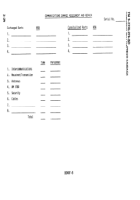TM-9-2350-274-BD - Page 57 of 219
TM 9-2350-274-BD
ENGINE
SECTION III. Engine Air Intake Systems
3-5. General.
Turbocharged engines use exhaust gases to drive the turbocharger to compress air and
force it into the cylinder under pressure. The engine air intake system therefore has
vacuum and pressure.
Repairs to turbocharged air intake systems must be done with
materials that do not bIock the air flow. The materials must be securely attached to
prevent them from being sucked into the system up to the turbocharger inlet. The
repairs must seal so that the air pressure is maintained from the turbocharger outlet to
the intake manifold. Care must be taken to keep the air induction system feeding the
turbocharger in good condition.
Air cleaners may become clogged with dirt and restrict
the air flow causing loss of power and incomplete combustion indicated by excessive
exhaust smoke. Clogged filters must be cleaned as soon as possible using compressed
air, nitrogen, a dismounted blower motor or other air supply. Leaking or damaged air
filters, housing or ducting will also cause damage by letting unfiltered air enter the
engine causing dust ingestion damage. The dust will cause rapid wear of internal engine
components and result in early engine failure.
Leaking components can be repaired
using tape, auto body filler, hose clamps and rags or any other similar materials
available.
1.
Air Cleaner Box - Left
2.
Air Cleaner Box - Right
3.
Air Inlet Ducts and Hoses
4.
Screw, Lockwasher and Flatwasher
5.
Support Bracket
Figure 3-5. Engine Air Intake System.
3-7
Back to Top




















